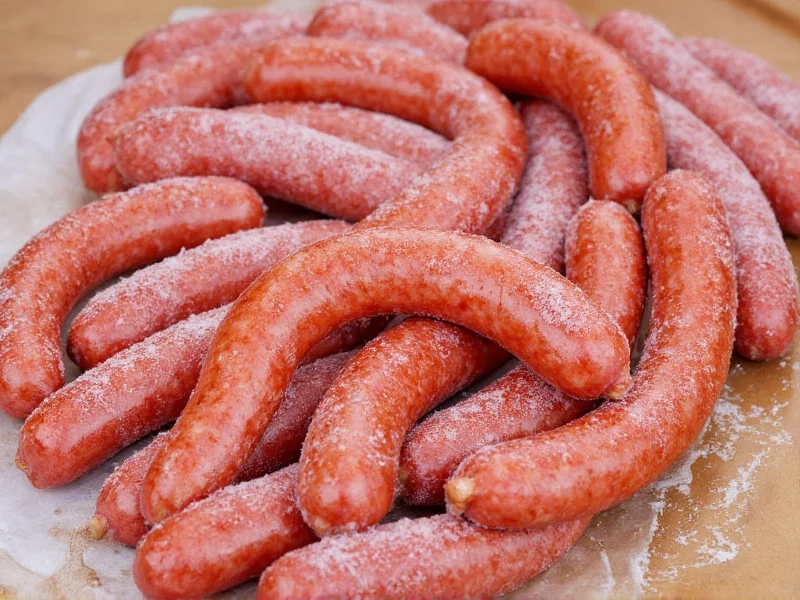When dealing with frozen sausages, understanding proper handling techniques prevents foodborne illness while maintaining optimal texture and flavor. Commercially frozen sausages undergo flash-freezing that preserves quality when stored correctly at 0°F (-18°C) or below. The key to successful preparation lies in adjusting cooking methods and times to accommodate the frozen state while ensuring thorough cooking throughout.
The Science Behind Frozen Sausage Preparation
Frozen sausages present unique challenges because ice crystals form within the meat matrix during freezing. These crystals affect heat transfer during cooking, requiring longer exposure to heat to reach safe internal temperatures. Unlike fresh sausages that cook relatively evenly, frozen varieties need careful attention to avoid undercooked centers while preventing overcooked exteriors.
Frozen Sausage Storage Guidelines
Proper storage maintains both safety and quality. Raw frozen sausages remain safe indefinitely at 0°F, though quality peaks within 1-2 months. Cooked frozen sausages maintain best quality for 2-3 months. Always store sausages in airtight packaging to prevent freezer burn, which occurs when moisture evaporates from the surface, creating dry, discolored spots that affect texture and taste.
| Sausage Type | Optimal Freezer Storage | Signs of Spoilage |
|---|---|---|
| Raw pork sausages | 1-2 months | Grayish color, sour smell, slimy texture |
| Raw poultry sausages | 6-9 months | Yellowish tint, ammonia odor |
| Cooked sausages | 2-3 months | Freezer burn, dry texture |
| Smoked sausages | 1-2 months | Rancid odor, mold growth |
Thawing Methods: When and How to Do It Properly
While many sausages cook well from frozen, certain situations warrant thawing first. Delicate sausage varieties with high fat content or those intended for stuffing benefit from gradual thawing. The USDA recommends three safe thawing methods:
- Refrigerator thawing: Place sealed sausages on a plate in the refrigerator (allow 24 hours per pound)
- Cold water thawing: Submerge sealed packages in cold water, changing water every 30 minutes (30 minutes per pound)
- Microwave thawing: Use defrost setting and cook immediately after thawing
Never thaw sausages at room temperature, as this allows bacteria to multiply rapidly in the "danger zone" between 40°F and 140°F.
Cooking Techniques for Frozen Sausages
Different cooking methods require specific adjustments when working with frozen sausages. Understanding these variations ensures consistent results whether you're using an oven, stovetop, grill, or air fryer.
Oven Baking Frozen Sausages
Preheat oven to 375°F (190°C). Arrange sausages on a parchment-lined baking sheet with space between them. Bake for 25-35 minutes, turning halfway through, until internal temperature reaches 160°F. For crispier results, increase temperature to 400°F during the last 10 minutes. This method works exceptionally well for frozen sausage cooking time in oven scenarios where even heating matters most.
Stovetop Cooking Methods
Place frozen sausages in a skillet with ½ inch of water. Cover and simmer for 10-12 minutes until thawed, then remove lid and continue cooking 8-10 minutes until browned and fully cooked. This two-stage approach prevents the exterior from burning before the interior reaches safe temperatures. For those searching how to cook frozen sausages on stove, this technique delivers reliable results every time.
Air Fryer Instructions
Air fryers excel at cooking frozen sausages quickly while maintaining texture. Preheat to 380°F (193°C), place sausages in a single layer, and cook 12-15 minutes, shaking the basket halfway through. The circulating hot air creates a crispy exterior while ensuring thorough cooking. Many users find this the best way to cook frozen sausages when seeking convenience without sacrificing quality.
Safety Considerations for Frozen Sausage Preparation
Food safety remains paramount when cooking from frozen. The critical factor is achieving proper internal temperature throughout the sausage. Visual cues like color change can be misleading, especially with certain sausage varieties containing fillers or preservatives that affect appearance. Always use an instant-read thermometer inserted horizontally through the side of the sausage to verify 160°F (71°C) in the thickest part.
Cross-contamination risks increase when handling frozen sausages. Keep raw sausages separate from ready-to-eat foods, use dedicated cutting boards, and wash hands thoroughly after handling. Never reuse marinades that contacted raw sausage unless boiled for two minutes first.
Common Mistakes to Avoid
Many home cooks make preventable errors when preparing frozen sausages. Understanding these pitfalls improves results significantly:
- High-heat rushing: Cranking up heat to shorten cooking time creates burnt exteriors with raw centers
- Crowding the pan: Overfilling cooking surfaces lowers temperature and steams instead of sears
- Skipping resting time: Allowing sausages to rest 3-5 minutes after cooking redistributes juices
- Assuming uniform size: Varying sausage thickness requires individual temperature checks
Nutritional Considerations
Frozen sausages maintain similar nutritional profiles to fresh counterparts when properly stored. However, extended freezer storage can cause slight nutrient degradation, particularly in vitamin content. Most commercially frozen sausages contain preservatives that help maintain quality during freezing. When comparing frozen sausage nutritional information, check sodium levels as some varieties contain higher salt content for preservation.
Practical Applications and Recipe Integration
Frozen sausages work well in many dishes where thorough cooking occurs. Add them directly to soups, stews, and casseroles during the cooking process, allowing extra time for the sausages to heat through. For breakfast applications, partially cook frozen sausage patties before adding to sandwiches to ensure they reach safe temperatures alongside other ingredients.











 浙公网安备
33010002000092号
浙公网安备
33010002000092号 浙B2-20120091-4
浙B2-20120091-4